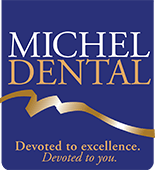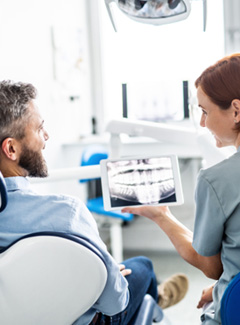
Gum Disease Treatment – Topeka & Silver Lake, KS
We Stop Gum Disease As Early As Possible
Gum disease, also known as periodontal disease or pyorrhea, is a condition many otherwise healthy individuals may unknowingly have. According to the Centers for Disease Control and Prevention, nearly 50 percent of Americans over the age of 30 have some degree of gum disease. In adults over the age of 65, the occurrence increases to slightly more than 70 percent. So although you may be in crowded company if you have gum disease—gingivitis, periodontitis or advanced periodontitis—treating this bacterial infection is important for your oral health as well as your overall health.
Why Choose Michel Dental for Gum Disease Treatment?
- Soft Tissue Laser Technology For Precise, Comfortable Care
- Topical Antibiotics Help Keep Bacteria At Bay
- Two Convenient Office Locations in Topeka & Silver Lake
Signs and Symptoms of Gum Disease
Bleeding gums that are red and swollen are often the first, and only, indication that periodontal disease is present. At this early stage, the effects of gum disease may be reversible with stringent oral hygiene care at home. Never under-estimate the value of twice daily brushing and flossing at least once a day. When you brush your teeth with a soft toothbrush and fluoride toothpaste you remove plaque from the surfaces of your teeth. Likewise, flossing gets rid of plaque buildup in between your teeth.
What’s so important about removing plaque? Living in plaque are the bacteria that initiate tooth decay and gum disease. In the case of gum disease, plaque likes to settle along the gum line. Here, the bacteria feed on food particles and excrete toxins. These toxins are the culprits that can destroy gum tissue as well as the underlying bone structure that supports your teeth.
Left untreated, the condition only worsens and may ultimately result in tooth loss, gum deterioration, and more. In addition, the bacteria that cause this gum tissue infection can spread throughout the body and increase your risk of a number of bodily illnesses and diseases. Called the oral-systemic connection, dentists and doctors now recognize the link between the health of your gums and your overall health. Diseases such as heart disease, pulmonary infections, gastric ulcer re-infection, diabetes, depression and pre-term, and low birth weight infants are only some of the conditions that have been linked to periodontal disease.
Scaling & Root Planing

Scaling and root planing are two parts of an in-depth cleaning that specifically targets the harmful bacteria causing gum disease. First, one of our talented hygienists will eliminate plaque and hardened tartar from around and below the gum line with special instruments. Once this step is complete, they move to the tooth roots, smoothing their surfaces at a gradual pace. This makes them less receptive to clinging bacteria and helps reduce the risk of further inflammation.
Do I Need Scaling & Root Planing?

If you're noticing signs of gum disease like bleeding while brushing or flossing, gum recession, chronic bad breath, visible plaque buildup, or swollen gums, your dentist may recommend scaling and root planing. These deep cleaning procedures help halt the progression of gum disease when at-home care isn't enough. While early stages can sometimes be reversed with good oral hygiene, advanced gum disease may require professional treatment to prevent further damage to your gums and teeth.
The Process of Scaling & Root Planing

When performing a deep cleaning for your gums, we begin with scaling. Using specialized dental tools, we carefully remove tartar from around the gumline and between the roots and inner gum tissue. Once the infection is cleared, we proceed to root planing, where we smooth the tooth roots with precision instruments. This helps prevent future buildup and promotes gum tissue reattachment. In more severe cases, multiple appointments may be necessary to complete the treatment effectively.
Aftercare Tips for Scaling & Root Planing

After scaling and root planing, it may take a few weeks for your teeth and gums to fully recover. During this time, increased sensitivity and discomfort are normal. To help speed up the healing process, rinse with warm saltwater after meals, use a soft-bristled toothbrush, and avoid spicy, hot, or acidic foods. Stick to a soft diet for the first 48 hours and avoid smoking or chewing tobacco. Limiting physical activity can also help speed up recovery.
Soft Tissue Laser

With soft tissue laser technology, treating gum disease has never been more comfortable! This focused beam can eliminate dangerous bacteria and remove infected portions of tissue while leaving healthy areas safely intact. Additionally, the instant sterilization it provides will keep any bleeding, swelling, or other uncomfortable symptoms to an absolute minimum. Many of our patients don’t even require local anesthetic because they already feel so at ease in the dental chair.
Antibiotic Therapy

In order to help patients better maintain their renewed periodontal health, our dentists will recommend the application of a topical antibiotic. This medication is applied directly to the gum tissue so that it can continue fighting off infection for days and even weeks following your initial cleaning. By eliminating dangerous bacteria to an even more comprehensive degree, antibiotic therapy can even help reduce the size of a patient’s deep periodontal pockets over time.
I Need a Checkup & Cleaning I Have a Cavity or Broken Tooth I am Missing One or More Teeth I Have a Dental Emergency I want to Improve My Smile I am Anxious or Scared of the Dentist I Want a Straighter Smile I am Concerned About Sleep Apnea I Have Pain When I Open/Close My Mouth View Our Services